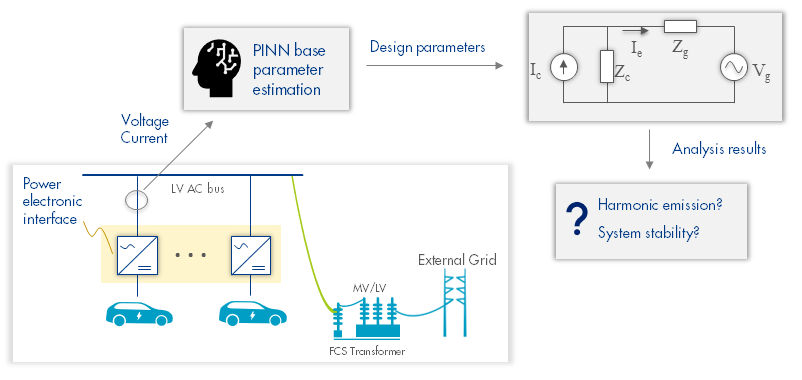Physics Informed Neural Net Model for The Parameter Estimation of EV Chargers
22 september 2022 12:30 t/m 23 september 2022 21:24 - Locatie: Online - Door: DCE&S | Zet in mijn agenda
MSc thesis off Vinay Kiran
The impedance-based approach is promising to analyse the harmonic emission and stability of a converter-based system, e.g., an EV fast charging station. When extracting the accurate impedance model of an EV charger, the knowledge of the charger’s circuit and controller parameters is indispensable. However, EV chargers’ manufacturers do not disclose the design parameters of chargers since they are confidential designs. Therefore, developing an approach to estimate the charger’s design parameters is practically beneficial for establishing the charger’s impedance model and thereby analysing the harmonic and stability of the charger-grid system. Recent works on physics-informed machine learning provide a promising data-efficient approach to estimating unknown parameters of a system with a known physical model. However, to the author’s knowledge, such a technique has never been applied in the power electronics domain. Thus, exploring whether PIML is also suitable for the parameter estimation of power electronic converters and how to implement this technique is worthwhile. In this thesis, to begin with, a Physics Informed Neural Net model is developed as a proof of concept to estimate the parameters of the boost converter. And subsequently applied to the AFE converter of the Fast-Charging Station to explore the scalability and generalisation of the model developed. Implementing the physics model within the neural net is still an open problem; hence the physics parameters are estimated similarly to the weights and biases during the training process using the existing optimiser. This approach requires diving deeper into the development of the neural net, and hence instead of eager execution, TensorFlow’s computational graph method is used to build the neural net and the physics model. This allows complete flexibility to build the network from scratch with added complexity. In the PINN model developed for the boost converter, the mean estimation error was 0.89%, and the parameters were estimated in 25.76 seconds. Because of the complexity of the physics model, optimizing the PINN model was challenging for the AFE converter. With a mean estimation error of 30.25%, the PINN model for the AFE converter took 361 seconds to execute. For both models, less than 150 data points collected over 25 switching cycles peak-to-peak values are used. The proposed PINN model developed in this thesis thus proves to be highly data-efficient with quick convergence. Despite the success of the developed PINN model, several drawbacks of PINN-based parameter estimation are also noticed and summarised.
